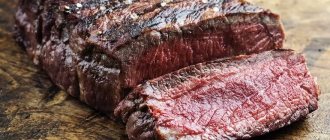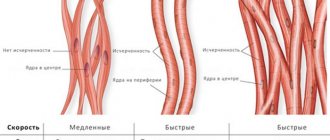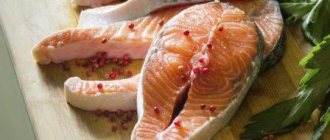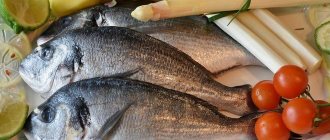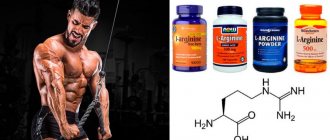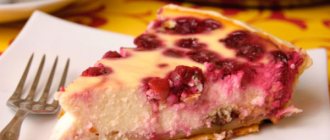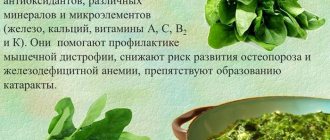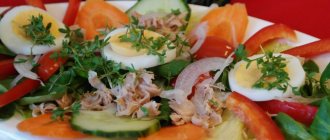Scientists have long proven that fish plays a key role in dietary nutrition. A gastroenterologist will explain what kind of fish you can eat if you have concomitant diseases, but its presence in the diet is mandatory. Therefore, it should be included in the menu of those losing weight. Useful microelements and vitamins ensure health, and Omega-3 fatty acids will give beauty to hair and nails. Therefore, eating fish will not only help you get rid of extra pounds, but also maintain your external beauty.
What are the benefits of fish for humans?
Before using the product in your diet, you should find out what the benefits of fish are for losing weight. Its pulp is useful due to its low-calorie protein content, which contains 25%. Easily digestible amino acids are digested in the stomach in 1.5-2 hours. It is also useful due to the presence of polyunsaturated fatty acids Omega-3 and Omega-6. They strengthen the heart, prevent heart attacks, strokes, and atherosclerosis. Fatty acids cleanse blood vessels of cholesterol, stimulate the functioning of the brain and nervous system, and restore metabolism. Fish contains a lot of vitamins A and D, minerals - phosphorus, iodine, fluorine, calcium. They help strengthen bones and teeth. It is ideal to include protein fish dishes in the menu three to four times a week. To lose weight, you should increase this amount to daily intake. In addition to the benefits, there are also harms:
Do you want to lose weight? Then these articles are for you
Zucchini pancakes recipe is simple and tasty dietary
14 Sauces for the PP diet
PP pancakes for Maslenitsa
- a fresh carcass may contain helminths and parasites;
- a large carcass contains a lot of mercury and harmful metals;
- fatty varieties are very high in calories and will not help you lose weight, like salty and fried foods;
- smoked product contains carcinogens that cause tumors;
- Constant consumption of fish without including meat in the diet threatens iron deficiency.
Is sea bass an oily fish or not? general characteristics
Sea bass is a deep-sea predatory fish that lives in the waters of the Pacific and Atlantic oceans (mainly in the northern part). This is a fairly large fish, some representatives can reach a meter in length and weigh about 20 kg. True, such giants are becoming increasingly rare.
The Latin name of this genus “Sebastes” has Greek roots and is translated as “magnificent”. At first glance, it may seem that there is little that is magnificent about this fish (not to say that some of its representatives even look menacing), but it is enough to take a closer look at sea bass to understand that they are truly magnificent.
The family of these fish is very large. Under the general name “sea bass,” experts mean more than 100 varieties. They can be plain, striped or spotted. Although pink-red groupers are most common, their color can vary depending on their habitat (from bright red to blue-green or even dark gray). Darker representatives of the family are found in coastal areas, while bright ones are found in deep water. The most popular varieties of sea bass are Atlantic golden, Pacific beaked, beaked and longfin snapper.
Like other deep-sea fish, the eyes of groupers are round and bulging, and the mouth, like most predators, is wide. What makes their appearance a little frightening are the massive bony plates on their heads and large spines on their fins. By the way, the dorsal fins of this fish contain a toxic substance. It is not mortally dangerous, but it can still create some troubles for humans. For example, in the form of inflammation at the site of injury. Most groupers do not like to allow other marine inhabitants into their territory. They are passionate about protecting their home. During a potential threat, the fish straightens its spines and takes a defensive position.
Sea bass are long-lived fish. Experts believe that these creatures can live up to 200 years, although most live no longer than 60 years. By the way, you can determine the age of a fish by looking at the otoliths, on which, like a tree, age rings form. But these fish grow very slowly. Only after reaching 10 years of age do sea bass give birth in the form of viviparous fry. In one season, one female can give birth to about a million fry, which is an absolute record among viviparous fish. But unlike their parents, sea bass fry stay on the surface of the waters, where not all of them survive through the process of natural selection.
Some people mistakenly think that river perch and sea bass are varieties of the same fish. In fact, the difference between them is not only in habitat. If river perch is a representative of perciformes, then sea perch is a spiny-finned fish from the scorpionfish family.
Some of the species of sea bass are listed in the Red Book. And all because of the great demand for them. Therefore, today biologists around the world are calling on fish lovers to reduce their consumption of sea bass in order to create favorable conditions for the reproduction of their population.
Fat content per 100 grams of fish and seafood
High fat content (10 g or more) Atlantic herring, eel, sturgeon, stellate sturgeon, mackerel, sardines.
Medium fat content (from 5 to 10 grams) Salmon (Atlantic, coho salmon, sockeye salmon, chinook salmon), bluefish, catfish, rainbow trout, swordfish, catfish, capelin, carp, chum salmon, salmon, pink salmon
Low fat (2 to 5 grams) tilapia, halibut, mussels, sea bass, oysters, Pacific sea bass, chum salmon, tuna, hake.
Very low fat content (less than 2 grams) Pollock, pike, pike perch, crucian carp, cod, flounder, haddock, lobster, scallops, shrimp.
List
Let’s immediately limit the search to a list that includes low-calorie varieties of fish (we selected the most popular ones, that is, available in almost any store, regardless of the region):
- vobla;
- sea bream;
- asp;
- flounder, crucian carp, rudd;
- lemonema;
- pollock, sea bass, sole;
- navaga;
- haddock, blue whiting;
- carp, herring;
- tilapia, silver carp, cod;
- trout.
If we take specific varieties of these varieties, they are given in the table below along with their calories. Almost all low-calorie fish is white. The only red one on this list is trout (salmon family), but even with it, not everything is so simple. Its calorie content depends on the habitat, subspecies, and production processing. Some manufacturers indicate 97 kcal on the packages, others - 147. Therefore, look at this indicator when purchasing a carcass.
Important note! All these varieties of fish are low-calorie when fresh. Most of them retain this status when boiled, steamed and baked. When fried, smoked, canned (especially in oil), salted and pickled, they lose this property.
As for seafood, almost all of it is low in calories if cooked correctly. The exception is caviar and sea cocktails in oil.
Dietary and non-dietary fish list
Despite the fact that fish is very healthy, not all varieties are suitable for weight loss. To determine which fish has the lowest calorie content, you need to know its fat content. In some varieties of fatty fish, the caloric content can reach 300 kcal per 100 g, which significantly exceeds the caloric content of lean meat. Therefore, when you go shopping, it is better to take with you a list of suitable fish for your diet.
All fatty fish varieties should be removed from this list. These include:
- acne;
- mackerel;
- sprat
- halibut;
- fatty herring;
- sturgeon;
- stellate sturgeon;
- saury;
- catfish
The fat content in oily fish is over 8%.
There are also moderately fatty representatives of the aquatic world. The percentage of fat in them ranges from 4 to 8. This product is more pleasant and delicate in taste than low-fat varieties of fish. Marine animals of medium fat content include:
- sazanketa;
- carp;
- herring;
- silverfish;
- anchovies;
- pink salmon;
- lean herring;
- catfish;
- zander;
- trout;
- carp;
- horse mackerel;
- tuna;
- sea bass;
- cheese;
- sole;
- river bream;
- sea bream;
- ide;
- smelt;
- red-eye;
- oily fish;
- capelin (in spring).
The calorie content of moderately fatty varieties is 100-140 kcal, so they can be consumed occasionally on a fish diet for variety.
But still, low-fat fish for a diet is the best option.
The calorie content of such a product varies from 70 to 100 kcal per 100 g. The most dietary, with fat content up to 1%, are:
- cod;
- haddock;
- navaga;
- lemonema;
- pollock;
- pollock;
- river perch;
- vobla;
- crustaceans;
- shellfish
Do you want to lose weight? Then these articles are for you
Lost weight Anna Mikhalkova: photo, technique
Rules for anti-cellulite massage
Healthy herbal baths
Lean gills (1 to 2% fat) are:
- pike;
- zander;
- Argentina;
- crucian carp;
- flounder;
- Amur;
- white-eye;
- mullet;
- burbot;
- omul;
- pristipoma;
- grayling;
- whitefish;
- grenadier;
- lamprey;
- roach;
- whitefish;
- Sorog.
Dietary varieties of aquatic representatives with a fat content of 2 to 4% include:
- hekjerekh;
- tench;
- rudd;
- mackerel;
- halibut;
- hake;
- ice fish;
- saber fish.
Regular consumption of fish with a fat content of up to 4% will help not only quickly lose excess weight, but also improve your body health.
Which fish to choose on your diet?
The best option would be white fish. This includes species such as cod, hake, pollock, and flounder. They are the lowest in calories: they contain up to 2% fat.
Cod
Calorie content:
78 kcal / 100 g. This fish has a delicate taste. It is useful to eat not only its fillet, but also the liver, in which fatty acids are concentrated. Cod helps remove bad cholesterol from the body and strengthens the central nervous system.
Hake Calories:
86 kcal / 100 g. This fish has no carbohydrates at all, but at the same time there is a lot of protein. 100 g of this product contains more than the daily requirement of iodine, which improves the functioning of the thyroid gland. Hake also eliminates endocrine disorders, reduces blood glucose levels and helps fight nervous disorders.
Photo: istockphoto.com
Pollock Calories:
72 kcal / 100 g. Improves blood circulation, and the substances it contains promote the production of the main thyroid hormone - thyroxine. Therefore, regular consumption of pollock has a positive effect on the functioning of the endocrine system.
Flounder Calories:
83 kcal / 100 g. Serves as a source of polyunsaturated fatty acids, which reduce blood lipid levels, stabilize heart rate, blood pressure and prevent the formation of blood clots in blood vessels.
Tender pike perch soufflé
Fish soufflé is an excellent option for those who, while on a diet, want to diversify the menu with an exquisite and delicate dish. For this recipe you will need a couple of cloves of roasted garlic; it is better to prepare it in advance.
Required ingredients:
- Fresh pike perch – 350 gr.
- White of two eggs.
- Low-fat cream – 100 ml.
- Baked garlic.
- Ground pepper.
- Salt.
Cooking method:
Cut and rinse the pike perch carcass, separate the bones and skin. Cut the resulting fillet into small pieces and place in a blender.
Do you want to lose weight? Then these articles are for you
At what heart rate does fat burn?
Recipe for fish in sour cream in the oven
Massage by Rene Koch
Advice from nutritionists
In general, to lose weight, you don’t have to push yourself too hard and give up many foods. Proper nutrition, including low-calorie healthy foods, is important.
But fish is important for weight loss. It not only satisfies hunger, but helps normalize the endocrine system. Its improper functioning leads to hormonal imbalances and the appearance of excess body weight.
In addition, such fish contains polyunsaturated acids. Their deficiency leads to diabetes, weakening of bone tissue, the appearance of cardiovascular diseases, and an increase in bad cholesterol in the blood.
Here are some tips that nutritionists recommend following in order to get the maximum benefit from eating fish:
- Consume at least three 100 gram servings of seafood per week. This is a fillet without bones and skin on top. The side dish can be boiled or stewed vegetables.
- Avoid fried, smoked, salted and dried fish. Frying, pickling or smoking fish products leads to the appearance of harmful substances in the meat, which leads to the appearance of cholesterol plaques in blood vessels and the formation of tumors.
- Don't get carried away with canned food. We must remember that they contain a lot of fat and salt, this contributes to fluid retention. In addition, manufacturers do not always comply with GOST, which can have a detrimental effect on human health.
- Prepare fish products in boiled, stewed and baked form. But the best way to cook it is steamed. Healthy components and taste are preserved.
- An excellent option would be baking in the oven, making fish soup or soup.
Fish diet
Pour the cream into the blender bowl, add the garlic and spices, and grind everything thoroughly. Separately, beat the whites with a pinch of salt.
Combine the fish mixture and whipped whites in parts to obtain a homogeneous mass. The consistency of the mixture should resemble cream.
While the oven is preheating to 150 0C, form the soufflé. To do this, transfer the mass onto cling film, twist it so that it looks like a sausage, and tie the film well at the ends. Wrap the formed soufflé in foil and place in the oven for 20-30 minutes.
At the same time, you can bake vegetables for a side dish. Remove the package from the oven, let it cool, cut into portions, and serve with vegetables. This soufflé is unusually airy, delicious both hot and chilled.
List of varieties of low-fat sea fish for diet: table with prices
Low-fat sea fish is an integral part of a healthy diet for an adult and should definitely be included in the menu for children.
The high content of vitamins, minerals and amino acids makes this product a real gift for our body, allowing us to satisfy the feeling of hunger for a long time, while saving us from extra calories.
If you monitor your health, want to have a slim figure, shiny hair and a strong immune system, fish dishes should be present on your table as often as possible.
There are three categories based on the amount of accumulated fat:
In dietary nutrition, fish of lean (low-fat) varieties has the greatest value. It is these varieties that nutritionists recommend eating at least three times a week.
The best low-fat varieties of fish for the diet are cod, pollock, pollock, flounder, amur pike perch, mullet, carp, trout, hake. It is their meat that saturates our body with a sufficient amount of calcium, iodine and phosphorus and helps to most naturally solve the problem of losing weight.
When compiling a dietary menu, be sure to include lean breeds in the list:
| Name | Fat, gram / 100 grams | Protein, gram / 100 grams | Calorie content, kcal / 100 grams | Average price, rub. / kg |
| Cod | 0,6 | 16 | 69,0 | 170 – 300 |
| Far Eastern flounder | 3,0 | 15,7 | 90,5 | 150 — 800 |
| Pollock | 0,9 | 15,9 | 73,7 | 65 — 95 |
| Tuna | 3,9 | 24,4 | 136,0 | 190 — 270 |
| Icy | 1,4 | 15,5 | 75,0 | 750 — 950 |
| Blue whiting | 0,9 | 16,1 | 72,3 | 55 — 80 |
| Halibut | 3,0 | 18,9 | 103,0 | 450 — 730 |
| Small saury | 0,8 | 20,3 | 143,2 | 95 — 120 |
| Sea bass | 3,8 | 17,6 | 117,9 | 235 — 320 |
Low-fat white fish with the best digestibility include haddock, cod and flounder. They contain a sufficient amount of B vitamins, phosphorus and iodine. These varieties have excellent taste, and flounder meat is almost boneless.
The most dietary red fish are trout and pink salmon. They contain only 4 - 7% fat per 100 grams, while the fat content of salmon and salmon can reach 15 - 18%.
Is it possible to replace fish
Seafood is a storehouse of unique vitamins and minerals that are difficult to find an alternative to. Fish is often called a meat substitute, especially for dietary purposes. There are times when you become allergic to delicacies, then you have to think about an alternative.
On a diet, you can replace fish with products of plant origin. These include soybeans, tofu cheese and some types of legumes. For example, in terms of amino acid content, one serving of lentils is in no way inferior to the same amount of fish delicacy. On the negative side, amino acids of plant origin are absorbed much worse.
You can replace fish in your diet with mushrooms and nuts. If you choose cashew nuts, then in addition to proteins and amino acids, the body will be enriched with phosphorus. When choosing nuts or mushrooms for your diet, remember that the daily portion should not exceed 50 g.
An excellent alternative to dietary fish delicacies is flaxseed. In addition to fatty acids, they contain zinc, iron and calcium. Flax seeds can be ground into flour, consumed with kefir for breakfast or as an independent dish instead of porridge. You can replace fish with seaweed, which makes nutritious dietary salads.
Lean fish without bones. What does caloric content depend on?
Fat content
Low-calorie foods include fish and seafood, which contain no more than 100 kcal per 100 g of product. This concept should not be confused with fat content. Among the low-fat varieties there are many high-calorie ones: for example, beluga (147 kcal), sea bream (135), striped bass (124). And vice versa: there are low-calorie varieties with medium fat content: silverfish (84), sole (88), bighead (94). Among the fatty ones, we can mention the toothed greenling - it contains only 85 kcal.
Varieties
The same type of fish has many subspecies. Due to different habitats, diets and lifestyles, their calorie content may vary significantly. For example, ocean crucian carp belongs to low-calorie varieties (91 kcal), but Cape Cod carp no longer falls into this category (126). Or perch: Atlantic sea bass - 96, sea bass - 112, striped - 124. So, when looking for fish fillets for your diet in the store, you will have to clarify which subspecies it is.
Cooking method
The calorie content of fish directly depends on the method of its preparation. Compare: fresh pollock - 72 kcal, boiled - 79, baked - 80, hot smoked - 101, fried - 123, cold smoked - 141, salted - 235. Therefore, even the lowest calorie varieties cease to be dietary as soon as they are fried in oil, smoke or pickle.
Additional Ingredients
Calorie content depends not only on the cooking method, but also on what additional ingredients are in the recipe. For example, if you bake flounder in the oven with lemon, zucchini, tomatoes and eggplants, you will get a low-calorie dish weighing 60 kcal. But, if you fry the same fish in batter and a lot of oil, it will cost your diet 120 kcal.
Mayonnaise, heavy cream, oil for frying, breading, batter - all this will turn the most dietary seafood into a high-calorie bomb that will threaten your waist with extra centimeters. Vegetables, vinegar, lemon juice, dry white wine for sauce - look for only healthy ingredients in recipes.
Important conclusion. In connection with all of the above, and also taking into account that the calorie content of fish depends on many smaller factors (its habitat, nutrition, production methods of processing), please note that the lists and tables given below are conditional and very relative. The specific calorie content of a particular carcass can only be found in the store. It is indicated on the packaging or (if sold without it) in the accompanying documents.
Fish recipes that promote weight loss
There are many recipes for preparing fish dishes.
We offer you several of them. Cream soup. Cut 600-700 grams of lean fish fillet into pieces and fry it in a non-stick frying pan without oil with onions and carrots (clean and wash first).
Make broth from fish heads. Separately fry 2-3 tbsp. tablespoons of flour and gradually pouring in 1-1.5 liters. broth, bring to a boil, and then place the fish with vegetables there and cook for another 15 minutes. Rub the resulting mixture through a sieve, if desired, you can add hot water or the rest of the broth, or a small piece of butter. Minimum salt, finely chop the herbs and sprinkle on top. Canned fish soup. Cut one leek, one zucchini into cubes, two bell peppers (preferably different colors) into strips and simmer it all over low heat.
Then put it in a saucepan, put one can of canned fish in small pieces and pour 1.5 liters of boiling water, add spices. Cook for 15-20 minutes. Sprinkle soup in bowls with herbs. Greek cod fillet. For a good aroma of this dish, two tbsp.
Fry tablespoons of coriander seeds in a frying pan, stirring constantly, and crush in a mortar (or grind in another way). Marinate two pieces of cod fillet in a mixture of wine vinegar (or lemon juice), ground coriander and various herbal seasonings for 5-10 minutes. Place the fillets on a greased baking sheet (or any baking dish). Cook in the oven at 180 degrees for 25-30 minutes. Pike perch soufflé. Prepare a couple of cloves of roasted garlic in advance. Take 350-400 grams of pre-peeled and pitted pike perch. Cut into small pieces and grind in a blender, adding garlic, ground pepper and 100 ml of cream with a small percentage of fat. Beat two egg whites separately with a little salt. Combine all ingredients, the mass will turn out creamy. Place the mixture on cling film and, having distributed it, roll it into a sausage shape, tie the film at the ends and wrap everything in foil. Bake in the oven at 150 degrees for 25-30 minutes. Can be served with baked vegetables at the same time.
Fish casserole from canned fish. Divide into inflorescences and boil 200 g for 5-7 minutes. cauliflower. Place canned fish (1 jar) in a bowl (only fish without liquid) and mash with a fork. Mix 100 grams of low-fat cottage cheese with two tablespoons of kefir. Grease a baking dish with oil, spread the curd mass on it and spread the fish mass on top of the cottage cheese, lay the onion and cabbage cut into half rings in the next layer. Beat two chicken eggs with one spoon of kefir and a little salt and pour this into the dish. You can add finely chopped greens to the eggs. Bake in the oven at 180 degrees for 20-25 minutes.
Expert opinion
Marianna Sergienkova
Expert of the LiteDay project. Pharmacist, certified fitness trainer, leads exercise therapy, Pilates, step and aerobics groups, 27 years old
Ask a Question
If you follow a fish diet, you should exclude fish cooked in batter from the menu, you will have to give up mayonnaise, even light mayonnaise, and sour cream. If you follow a fish diet, you can lose up to 1.5 kg in three days, and if you maintain a course of 7 to 10 days, your body weight can decrease by 3 - 5 kg by the end of the course. And include a set of exercises in your weight loss program, at least in the form of morning exercises or 15 minutes of walking on an elliptical trainer. Or walking. This increases the effectiveness of diets, although it works unnoticed!
Which one is better and how to cook it
Even on the most democratic Dukan diet, you can eat this product at any stage. In the first phase, Dr. Dukan focuses on proteins and prohibits carbohydrates, fats and sweets. Fish is not the last place in the food system. During all stages of the diet, almost any diet is allowed - sea or river. You can even have a little piece of smoked salmon. I wrote in more detail in an article about allowed foods on the Dukan diet. Products can be boiled, steamed, fried or baked in foil. But with a minimum amount of vegetable oil.
Now let's move on to the most delicious moment. Fish recipes for diets are a separate science. They need to take into account the usefulness of a particular variety. And also how safe it will be to use if you have gastritis or diabetes.
Cooking
I recommend including the following types of seafood in your diet: tuna, flounder, haddock, pollock, cod, as well as shrimp and crabs. See the table above for other types with low and very low fat content. But the amount of protein in such meat is high.
To reduce calorie content, you can boil the fish in water or steam it. The last method is the healthiest and tastiest. The meat turns out juicy and tender. For flavor, sprinkle the pieces with a little lemon juice and add a sprig of herbs (dill, parsley). Sprinkle with aromatic fish seasoning and wrap in foil. In 30 minutes it will be ready.
A plate of fish soup without potatoes is an excellent dietary dish. You can eat as much as you want without any consequences on your waistline. A very tasty broth is made from pike. Minimum calories with amazing aroma.
Try to use less sauces. They provoke appetite. If you don’t like the fishy smell, soak the seafood in milk for an hour. The unpleasant aroma will disappear.
Some of my people complain that the fish falls apart when cooked. Try cooking cod. Its fillet is not as tender as other species. Or you can use a little trick. Add a little vinegar to boiling water and boil the fish calmly. The aromatic fillet will not fall apart.
Bake
Recipes for weight loss contain a minimum of oil. The baking process itself involves cooking the product simultaneously from all sides in the oven. At the same time, the fish turns out much tastier than with banal boiling.
Foil or a sleeve is suitable for baking. Nutritionists have noticed: oven-fried foods are much healthier than those fried in a frying pan. Pieces of fish can be “released from protection” a few minutes before they are ready. Then you will get a delicious crust without butter. Or try baking it in natural yoghurt. The taste is indistinguishable from sour cream. But fewer calories.
Fish diet options and course duration
“Sitting” on a fish diet does not have to be for a very long time. You can simply arrange two or three fasting days a week. But if you want to lose weight as much as possible, you can take courses for 5-7 days. But it is necessary to organize such weight loss marathons no more than once a month, and the rest of the time you need to monitor a balanced diet; you can resort to a vegetable or dairy diet.
You should not immediately after the course lean on carbohydrates, fats, or smoked foods. Limit your portions slightly. Mentally divide your plate into two parts. In one of the parts, put vegetables, you can eat a lot of them (with the exception of potatoes), and divide the second part of the plate in half and put a piece of lean meat (or fish) on one small part, and a side dish on the second part. And by eating such a portion, you will completely satisfy your hunger.
Fish diets can be very diverse. It would seem how to combine meat and fish. But nutritionists have developed such a diet.
In the first version of this menu, you will have to eat 170-200 grams of lean fish and lean meat per day, 750-800 grams. vegetables, green tea. All this must be eaten in five doses throughout the day.
The second version of the fish-meat diet is divided into 6 steps and is more varied:
- Breakfast: two boiled eggs, a large glass of tea with lemon or 150 g. cottage cheese (yogurt), unsweetened fruit;
- Snack between breakfast and lunch, so-called lunch: 100-120 gr. boiled cod and a glass of water, you can fish and vegetables;
- Half an hour before lunch, drink a couple of glasses of water;
- Lunch: a quarter kilogram of fish, prepared in any way, a side dish in the form of a vegetable salad or just vegetables, 150-200 grams of natural yogurt;
- Dinner: everything is the same as for lunch, but prepare according to a different recipe.
- Drink herbal tea at night.
The diet can be based on canned fish, from which you can easily prepare a fairly large number of dishes: fish soup, salad, and simply eat with vegetables.
Just keep in mind when buying canned food that the fish in them should be low-fat varieties. You can arrange a fish and vegetable diet. Even people suffering from diabetes can arrange fasting days with lean fish, boiled or baked, cooked in its own juice or tomato sauce.
Product benefits
Fish is a source of high-quality protein and is quickly absorbed by the body. If it takes about three or four hours to digest the meat, then the fish will “dissolve” in two. Therefore, it is recommended in dietary nutrition even for evening meals. Proteins keep you feeling full for a long time. The brain “gives a signal” not to store anything on the sides or butt.
I think many people have heard about the longevity of the people of Japan. They have virtually no problems with the thyroid gland. Excellent vision and smooth skin last until old age. Just look at the photo - cheerful, youthful people. Scientists have found that the cause of health was the consumption of large amounts of sea fish. The composition of your favorite product includes the following benefits:
Regular consumption of seafood reduces the risk of heart disease. The pressure stabilizes. The functioning of the immune system and brain improves. If you don’t want to suffer from dementia in old age, eat fish.
Iodine - saturates the thyroid gland, which has a huge impact on calorie burning and metabolism. And Omega-3 fatty acid is a very healthy thing. Without it, the synthesis of other substances in the body is impossible. It maintains normal sensitivity of nerve fibers and participates in muscle contraction. The presence of beneficial Omega-3 acids will have a positive effect on hair, skin, and nails.
